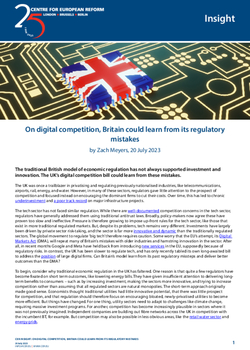
On digital competition, Britain could learn from its regulatory mistakes
The traditional British model of economic regulation has not always supported investment and innovation. The UK’s digital competition bill could learn from these mistakes.
The UK was once a trailblazer in privatising and regulating previously nationalised industries, like telecommunications, airports, rail, energy, and water. However, in many of these sectors, regulators gave little attention to the prospect of competition and focused instead on encouraging the dominant firms to cut their costs. Over time, this has led to chronic underinvestment and a poor track record on major infrastructure projects.
The tech sector has not faced similar regulation. While there are well-documented competition concerns in the tech sector, regulators have generally addressed them using traditional antitrust laws. Broadly, policy-makers now agree these have proven too slow and ineffective. Pressure is therefore growing to impose up-front rules for the tech sector, like those that exist in more traditional regulated markets. But, despite its problems, tech remains very different. Investments have largely been driven by private sector risk-taking, and the sector is far more innovative and dynamic than the traditionally regulated sectors. The global movement to regulate ‘big tech’ therefore requires caution. Some worry that the EU’s attempt, its Digital Markets Act (DMA), will repeat many of Britain’s mistakes with older industries and hamstring innovation in the sector. After all, in recent months Google and Meta have held back from introducing new services in the EU, supposedly because of regulatory risks. In contrast, the UK has been slower to regulate tech, and has only recently tabled its own long-awaited bill to address the position of large digital firms. Can Britain’s model learn from its past regulatory missteps and deliver better outcomes than the DMA?
To begin, consider why traditional economic regulation in the UK has faltered. One reason is that quite a few regulators have become fixated on short term outcomes, like lowering energy bills. They have given insufficient attention to delivering long-term benefits to consumers – such as by increasing investment, making the sectors more innovative, and trying to increase competition rather than assuming that all regulated sectors are natural monopolies. The short-term approach originally made good sense. Economists thought traditional utilities had little innovative potential, that there was little prospect for competition, and that regulation should therefore focus on encouraging bloated, newly-privatised utilities to become more efficient. But things have changed. For one thing, utility sectors need to adapt to challenges like climate change, requiring massive investment programs. For another, competition has become increasingly plausible in sectors where it was not previously imagined. Independent companies are building out fibre networks across the UK in competition with the incumbent BT, for example. But competition may also be possible in less obvious areas, like the retail water sector and energy grids.
Pressure on regulators to keep delivering ‘quick wins’ meant that regulation became increasingly entrenched and intrusive.
Most regulators adapted to these changes slowly. In the meantime, the pressure on regulators to keep delivering ‘quick wins’ meant that regulation became increasingly entrenched and intrusive. For example, the UK reintroduced retail price caps in the energy sector in 2019, and the UK’s payments regulator is now considering stricter regulation of Visa and Mastercard’s prices. This has short-term benefits. But it can have high long-term costs: if the incumbent is forced to offer a cheaper price, customers will have less reason to look elsewhere, and the market will not look as lucrative for new competitors. Regulation can therefore lock in market structures. In telecoms, a rare regulated sector where competition and investment are thriving, the regulator took the opposite approach: it loosened regulation of the ex-monopoly’s network prices in order to encourage new entrants to build their own networks, and removed regulation entirely once competition started to flourish.
If the short-term focus of most British regulators were applied to tech markets, it might help some UK start-ups, such as mobile app developers. Many of these developers want to reduce the commission they are forced to pay to Apple and Google to be listed on their app stores, for example. But if used too slavishly, this approach might damage the tech sector – leading to ever-increasing regulation, which might in turn constrain firms’ freedom to experiment, and reduce rather than enabling competition. Many tech markets do tend towards ‘winner takes all’ outcomes. However, tech regulators can tackle that problem in ways traditional regulators cannot, and incumbents can sometimes be dislodged with new innovations – so regulators should not be quick to treat tech firms as if they were inevitable monopolies. Tech regulation therefore ought to focus on long-term outcomes. It should be incisive but tightly targeted, focused on increasing competition and ensuring dominant players cannot hinder innovation. And regulators need to be ready to roll back regulations as soon as they are no longer needed.
The digital competition bill reflects these lessons in part. The bill provides the CMA with very broad discretion. That means there is at least the possibility that the CMA will design rules to promote long-term outcomes, rather than focusing on ‘quick wins’. Traditional regulation, such as in the UK’s energy sector, tends to be much less flexible. Take, for example, line-of-business restrictions. These are common in regulated sectors and constrain regulated firms from undertaking more than one type of activity. One rationale is that a regulated firm should not be able to use its monopoly in one market to distort competition in another market, for example by blocking their competitors from getting access to the monopoly asset. Yet these rules can be counterproductive. They have held back energy grids from offering innovative services, which can be cheaper and better than alternatives. They have also made it difficult for energy companies to make their own grid investments.
By contrast, if the CMA uses its flexibility appropriately, then it could deliver better outcomes. For example, rather than strict line-of-business rules, the CMA could design rules that allow big firms to expand their services, and only constrain them from doing so if it would reduce consumers’ choices or strengthen or extend a dominant position. Meta, for example, is using its Instagram userbase to help build demand for Threads, its new alternative to Twitter. The CMA should not prevent that happening. It is probably the only way Twitter users will get a genuine choice. Other potential competitors have all failed to attract enough customers.
The main downside of the UK’s digital competition bill is that, while the CMA is empowered to focus on long-term outcomes, the bill places enormous trust in the CMA’s judgement. It does little to ensure the CMA follows a long-term, pro-competition approach in practice. The bill may even discourage the CMA from long-term thinking – because the bill makes it too easy for the CMA to deliver ‘quick wins’ instead of designing rules for better long-term outcomes. It gives the CMA powers to make two different types of interventions, ‘conduct requirements’ and ‘pro-competition interventions’. The distinction between the two types of intervention is not clearly explained. But, generally speaking, conduct requirements will set guardrails on how big tech firms must behave – largely to ensure they act fairly and transparently and do not artificially constrain consumer choice. Conduct requirements are therefore akin to most of the rules that traditional economic regulators impose. By contrast, ‘pro-competition interventions’ are envisaged to be more radical changes to how a market functions.
Pro-competition interventions may prove complex, will have significant costs and risks, and will take time to achieve results. But they can tackle the root of the problems in tech markets. But while the bill allows the CMA to quickly and easily impose conduct requirements, it says the CMA must adopt a slower, more cautious process when considering imposing pro-competition interventions. This will encourage the CMA to rely too heavily on conduct requirements – which, since they only address the symptoms of poor competition, will probably proliferate over time. That approach may, in some cases, make it harder to address the underlying problem later. For example, if the CMA uses conduct requirements to force big tech players to offer more attractive terms to their customers, then new entrants will find it harder to offer a more attractive proposition to pry users away from the incumbents. That means consumers will lose out on the new entrants’ potential innovations, and the new entrants will impose less pressure on big tech firms to increase their rate of innovation.
There is a simple fix. The bill could simply combine ‘conduct requirements’ and ‘pro-competition interventions’ into one single type of intervention. The CMA should have to follow the same process, and the same timeline, for any intervention. The CMA should clearly identify a competition problem, explain how a rule or intervention would address the problem, consider if the rule might inadvertently hurt consumers, and consult on the design of that rule or intervention. Applying these requirements to any intervention would encourage CMA to focus on the risks of overregulation, and ensure its interventions are carefully targeted at making competition work effectively, rather than following a prescribed hierarchy of tools. It would also help assuage stakeholders who fret that there is limited opportunity to appeal the CMA’s rules. If the CMA is forced to explain its reasoning, then courts will find it easier to assess whether the CMA has rationally and properly considered all the evidence.
Removing the bias towards short-term interventions still leaves one problem unsolved: there is uncertainty about how the CMA will use its powers. The bill focuses almost entirely on procedures the CMA must follow. It provides little guidance to the CMA on how it should exercise its new powers. Should it focus on curbing big tech firms’ unfair practices in the short run? Or should it focus on reshaping digital markets to address barriers to competition and foster innovation in the long run? Nor does it explain what success looks like: for example, how will the CMA assess whether the market is delivering good outcomes for consumers? The bill would benefit from answering these questions, to further help ensure the CMA does not become dependent on delivering politically attractive ‘quick wins’.
Tech investments often require years of persistence to pay off – so small firms will not invest unless they trust that the CMA’s decisions will be predictable and will follow a long-term strategy.
By giving the CMA more flexibility, but also more direction, the bill could deliver a much more coherent competition policy for the tech sector than the EU’s DMA does – explaining what regulatory approach will be applied in each part of the sector, and when regulation will be lifted. The DMA’s shopping list of ‘do’s and don’ts’ for large firms has the virtue of being predictable. But it has neither coherence nor flexibility: some of the DMA’s rules target unfairness while others try to open up competition, with little overarching vision, nor any ability for the rules to adapt over time. Tech investments often require years of persistence to pay off – so small firms will not invest unless they trust that the CMA’s decisions will be predictable and will follow a long-term strategy. The CMA can take inspiration from the telecoms watchdog Ofcom, for example. Ofcom gave the telecoms industry a clear plan for how it would regulate new networks investments over a 10-year period. This approach increased investment and enabled new competition, which should deliver lower prices and better quality services for UK consumers in the long run.
Tackling market power in the tech sector can raise innovation, productivity and economic growth. But the UK needs to be mindful of how its established models of economic regulation have failed to focus on long-term outcomes, like innovation and investment. UK regulation has allowed many conspicuous failures in other economic sectors. UK lawmakers should do more to ensure the bill delivers a coherent, predictable competition policy for the UK tech sector.
Zach Meyers is a senior research fellow at the Centre for European Reform.
A number of technology companies including Amazon, Apple, Facebook, Google and Microsoft are corporate members of the CER. The views expressed here, however, are solely the author’s, and should not be taken to represent the views of those companies.




Add new comment